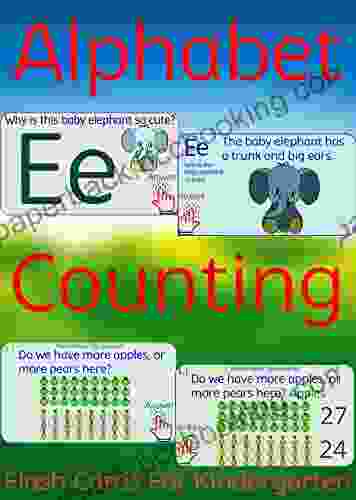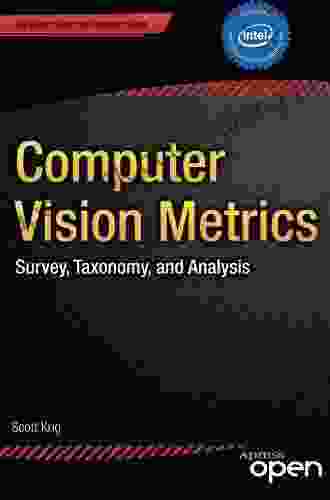Computer Vision Metrics: A Comprehensive Survey, Taxonomy, and Analysis

Computer vision is a rapidly growing field with applications in a wide range of areas, including healthcare, manufacturing, robotics, and self-driving cars. As the field has grown, so has the need for metrics to evaluate the performance of computer vision algorithms.
There are a wide variety of computer vision metrics available, each with its own strengths and weaknesses. Choosing the right metric for a particular task can be a challenge, and it is important to understand the limitations of any metric before using it.
This article provides a comprehensive overview of computer vision metrics, including a taxonomy, analysis, and discussion of their strengths and limitations. It also includes a detailed survey of existing metrics and their applications in various computer vision tasks.
4.4 out of 5
| Language | : | English |
| File size | : | 16771 KB |
| Text-to-Speech | : | Enabled |
| Screen Reader | : | Supported |
| Enhanced typesetting | : | Enabled |
| Print length | : | 499 pages |
Computer vision metrics can be classified into a number of different categories, including:
- Accuracy metrics measure the overall accuracy of a computer vision algorithm.
- Error metrics measure the difference between the output of a computer vision algorithm and the ground truth.
- Robustness metrics measure the ability of a computer vision algorithm to handle noise and other distortions.
- Efficiency metrics measure the speed and memory requirements of a computer vision algorithm.
- Interpretability metrics measure the ease of understanding the output of a computer vision algorithm.
Each of these categories contains a number of different metrics, each with its own strengths and weaknesses. The following table provides a summary of the most common computer vision metrics:
| Category | Metric | Description | |---|---|---| | Accuracy | Accuracy | The percentage of correct predictions. | | Error | Mean absolute error (MAE) | The average absolute difference between the predicted and actual values. | | Error | Mean squared error (MSE) | The average squared difference between the predicted and actual values. | | Error | Root mean squared error (RMSE) | The square root of the mean squared error. | | Robustness | Noise robustness | The ability of an algorithm to handle noise. | | Robustness | Occlusion robustness | The ability of an algorithm to handle occlusions. | | Robustness | Illumination robustness | The ability of an algorithm to handle different lighting conditions. | | Efficiency | Time complexity | The amount of time required to run an algorithm. | | Efficiency | Memory complexity | The amount of memory required to run an algorithm. | | Interpretability | Explainability | The ease of understanding the output of an algorithm. |
The choice of which computer vision metric to use depends on a number of factors, including the task being performed, the data being used, and the resources available.
The following are some of the key considerations when choosing a computer vision metric:
- Task: The task being performed will determine which metrics are most relevant. For example, if the task is to classify images, then accuracy is likely to be the most important metric.
- Data: The data being used will also affect the choice of metric. For example, if the data is noisy, then a metric that is robust to noise will be important.
- Resources: The resources available will also affect the choice of metric. For example, if the resources are limited, then a metric that is efficient to compute will be important.
In addition to these considerations, it is also important to consider the strengths and limitations of each metric. The following table provides a summary of the strengths and limitations of the most common computer vision metrics:
| Metric | Strengths | Limitations | |---|---|---| | Accuracy | Easy to understand and interpret | Can be misleading if the data is imbalanced. | | Error | Measures the absolute or squared difference between the predicted and actual values | Can be sensitive to outliers. | | Robustness | Measures the ability of an algorithm to handle noise and other distortions | Can be difficult to quantify. | | Efficiency | Measures the speed and memory requirements of an algorithm | Can be difficult to compare algorithms that have different time and memory requirements. | | Interpretability | Measures the ease of understanding the output of an algorithm | Can be difficult to quantify. |
There are a wide variety of computer vision metrics available, each with its own strengths and weaknesses. The following is a survey of some of the most common computer vision metrics:
- Classification metrics measure the accuracy of a computer vision algorithm in classifying images or videos. Common classification metrics include accuracy, precision, recall, and F1-score.
- Segmentation metrics measure the accuracy of a computer vision algorithm in segmenting images or videos. Common segmentation metrics include intersection over union (IOU),dice coefficient, and Hausdorff distance.
- Object detection metrics measure the accuracy of a computer vision algorithm in detecting objects in images or videos. Common object detection metrics include mean average precision (mAP),average precision (AP),and recall.
- Tracking metrics measure the accuracy of a computer vision algorithm in tracking objects in images or videos. Common tracking metrics include intersection over union (IOU),mean absolute error (MAE),and root mean squared error (RMSE).
- Quality assessment metrics measure the quality of images or videos. Common quality assessment metrics include peak signal-to-noise ratio (PSNR),structural similarity index (SSIM),and mean opinion score (MOS).
Computer vision metrics are an essential tool for evaluating the performance of computer vision algorithms. The choice of which metric to use depends on a number of factors, including the task being performed, the data being used, and the resources available.
This article has provided a comprehensive overview of computer vision metrics, including a taxonomy, analysis, and discussion of their strengths and limitations. It also includes a detailed survey of existing metrics and their applications in various computer vision tasks.
By understanding the different types of computer vision metrics and their strengths and weaknesses, you can make informed decisions about which metrics to use for your own computer vision projects.
4.4 out of 5
| Language | : | English |
| File size | : | 16771 KB |
| Text-to-Speech | : | Enabled |
| Screen Reader | : | Supported |
| Enhanced typesetting | : | Enabled |
| Print length | : | 499 pages |
Do you want to contribute by writing guest posts on this blog?
Please contact us and send us a resume of previous articles that you have written.
 Book
Book Novel
Novel Page
Page Chapter
Chapter Text
Text Story
Story Genre
Genre Reader
Reader Library
Library Paperback
Paperback E-book
E-book Magazine
Magazine Newspaper
Newspaper Paragraph
Paragraph Sentence
Sentence Bookmark
Bookmark Shelf
Shelf Glossary
Glossary Bibliography
Bibliography Foreword
Foreword Preface
Preface Synopsis
Synopsis Annotation
Annotation Footnote
Footnote Manuscript
Manuscript Scroll
Scroll Codex
Codex Tome
Tome Bestseller
Bestseller Classics
Classics Library card
Library card Narrative
Narrative Biography
Biography Autobiography
Autobiography Memoir
Memoir Reference
Reference Encyclopedia
Encyclopedia Sean Mccutchen
Sean Mccutchen Sophie L Morgan
Sophie L Morgan Stephanie Clarke
Stephanie Clarke Paul Pineapple
Paul Pineapple Marc Ecko
Marc Ecko Michael Hirsh
Michael Hirsh Robert Harms
Robert Harms Mike Epps
Mike Epps Mary Mcaleese
Mary Mcaleese Paul Curry
Paul Curry Peter Jaworski
Peter Jaworski Tiffani Bova
Tiffani Bova Tim Guest
Tim Guest Peter Schjeldahl
Peter Schjeldahl Vanessa Lachey
Vanessa Lachey Shlomo Sand
Shlomo Sand Maria Isabel Sanchez Vegara
Maria Isabel Sanchez Vegara Shelly Westerhausen
Shelly Westerhausen Mike Liner
Mike Liner Prashant Shah
Prashant Shah
Light bulbAdvertise smarter! Our strategic ad space ensures maximum exposure. Reserve your spot today!

 Carlos Drummond384 Color Paintings Of Ernst Ludwig Kirchner German Expressionist Painter And
Carlos Drummond384 Color Paintings Of Ernst Ludwig Kirchner German Expressionist Painter And William PowellFollow ·3.2k
William PowellFollow ·3.2k Bruce SnyderFollow ·8.6k
Bruce SnyderFollow ·8.6k Braden WardFollow ·2.8k
Braden WardFollow ·2.8k Benji PowellFollow ·2.4k
Benji PowellFollow ·2.4k Alan TurnerFollow ·6.9k
Alan TurnerFollow ·6.9k Robert Louis StevensonFollow ·3.7k
Robert Louis StevensonFollow ·3.7k Henry Wadsworth LongfellowFollow ·16.8k
Henry Wadsworth LongfellowFollow ·16.8k Vernon BlairFollow ·2.9k
Vernon BlairFollow ·2.9k

 E.M. Forster
E.M. ForsterBluewater Walkabout: Into the Pacific
An Unforgettable...

 Joseph Foster
Joseph FosterUnlock the Secrets of Standardized Test Success with Test...
Are you tired of struggling with standardized...

 Joe Simmons
Joe SimmonsUnlock Learning with Flash Cards for Kindergarten:...
Ignite a Passion for...

 Raymond Parker
Raymond ParkerJourney into the Enchanting World of "The Heart Kingdom"...
A Timeless Tale of Love,...
4.4 out of 5
| Language | : | English |
| File size | : | 16771 KB |
| Text-to-Speech | : | Enabled |
| Screen Reader | : | Supported |
| Enhanced typesetting | : | Enabled |
| Print length | : | 499 pages |














